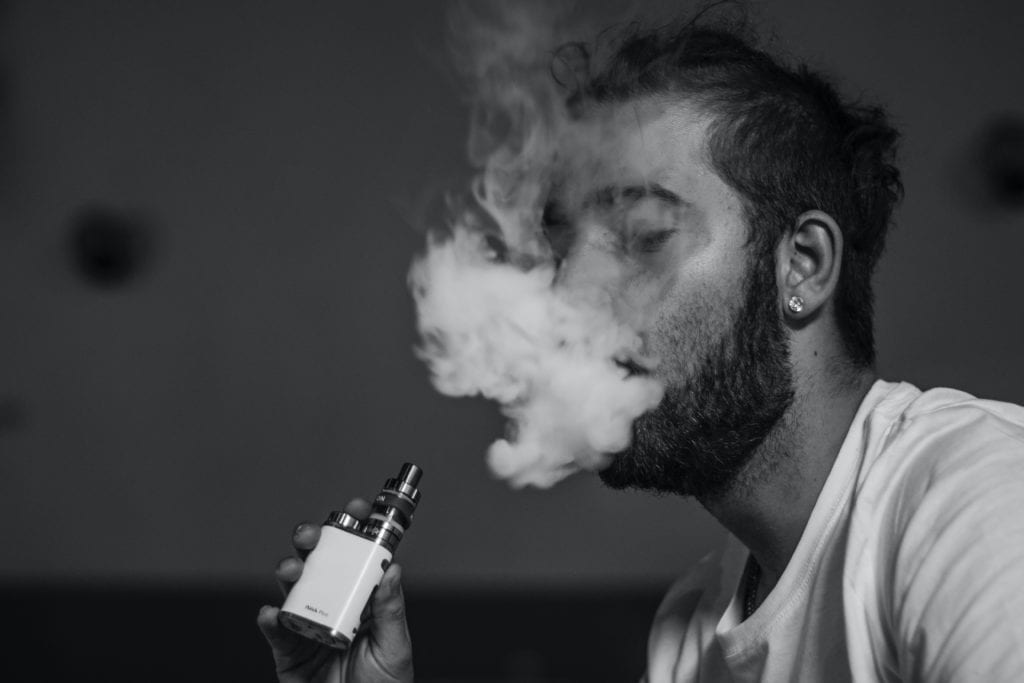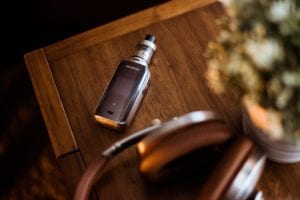Bad for Business
- This Issue
- August 17, 2020
- 15 minutes read


While there is little evidence that flavor bans prevent youth use, bans are forcing businesses to close.
By Timothy S. Donahue
As of Aug. 1, Jeff Barry no longer owns a vape shop. Barry, who once owned three retail stores in the state of New York, had to close his last store because of New York’s ban on flavored vapor products. During the past nine years, Barry has had to close six vape shops across two states. All because of overregulation.
Barry started vaping in 2008 to quit smoking combustible cigarettes. He was the part-owner of a logistics company. Soon he was buying devices for several other smokers to help them quit. A few months later, Barry was selling 30–50 devices a day and lots of e-liquid from his house. His vapor side business soon grew too large for his home. He sold his half of the logistics company. Barry then used $15,000 of his savings to open his first vape shop in New York. Then New York legislatures started talking about banning vapor products. So, Barry moved his business to Warren, Pennsylvania, in 2012.
Barry then opened a second and third vape shop in 2014 and 2015. He was going to open a fourth store in 2016 when it happened. That year, Pennsylvania Governor Tom Wolf signed off on a budget bill that included a massive new tax on electronic cigarettes. The estimated 350 vape shops scattered across Pennsylvania were devastated. The new 40 percent wholesale tax on all vapor equipment and supplies was even more crippling because the same 40 percent tax applied not only to purchases made after Oct. 1—the day the tax took effect—but also covered all inventory on store shelves on that date. A store with $100,000 worth of inventory owed the state $40,000.

“Fifty percent of all vapor stores closed in six months. I closed two stores in September of 2016 and my last store on Jan. 1, 2017,” says Barry. “I moved to one small location in New York in April 2017 and quickly opened two more stores over the next two years.” The entire time he was also doing advocacy work to help fight to keep life-saving vapor products on the market.
Like a bad dream, it happened again. Regulation would ruin Barry’s businesses. New York became the first state in the nation to restrict the sale of flavored vapor products. Snuck into a budget without debate on April 3 while most of the state’s citizenry was focusing on the Covid-19 pandemic, New York banned the sale of all flavored vapor products other than tobacco flavors. This was labeled a huge win for public health and the only real solution to the youth vaping issues. The e-liquid flavor ban went into effect on May 18, 2020, for brick-and-mortar sales and July 1 for online sales.
The Consumer Advocates for Smoke-Free Alternatives Association (CASAA), a nonprofit group, said in a release that the New York budget was passed under the guise of dire circumstances and that it was necessary to keep the state functioning in the midst of a crisis, but all of this was introduced by Governor Andrew Cuomo well in advance of the coronavirus outbreak in New York.
“Even under normal circumstances, voters and lawmakers are hard-pressed to amend or remove even the most egregious sections of the governor’s budget proposal,” the release stated. “There are deep cuts and rollbacks to other programs and reforms that will arguably threaten the health and financial security of millions of New Yorkers and, again, all of this was on the table before anyone was recommending austerity measures to slow the spread of Covid-19.”
Barry closed his first location on April 1. Then the second on July 1. He closed his last store on Aug. 1. “I have lost many nights’ sleep over these choices. Many people with no other option or accessibility to products in a convenient local will simply go back to smoking,” explains Barry. “Some will go to the Indian reservation (where products are not banned). Some will travel to other states to get their product.”
According to the Vapor Technology Association (VTA), in 2018, the vapor industry directly generated 87,581 jobs, including manufacturing, retail and wholesale employment. Those jobs generated more than $3.2 billion in just wages. The vapor industry has also created thousands of secondary jobs in the United States, bringing the industry’s total economic impact in 2018 to $24.46 billion.
In the same year, the industry generated more than $4.9 billion in taxes, according to the VTA. In 2016, 78 percent of e-liquid sales were flavored products, and 69 percent of disposable vapor product sales were flavored and menthol products.
Unreasonable action
Several state and local governments have now passed laws banning the sale of flavored e-liquids. In 2020, New Jersey, New York and Rhode Island enacted bans on the sale of flavored e-cigarettes. In 2019, eight states—Massachusetts, Michigan, Montana, New York, Oregon, Rhode Island, Utah and Washington—issued emergency rules to temporarily ban the sale of flavored e-cigarettes, according to the Campaign for Tobacco-Free Kids.
Barry says that New York’s government and other states that enact flavor bans will effectively eliminate a product that is 97–99 percent safer than combustible cigarettes. With the U.S. Food and Drug Administration’s (FDA) premarket tobacco product application (PMTA) due date looming (Sept. 9), the future of the vapor industry is still unknown.
“Just because the government took the legality away does not mean they took the passion to help people quit smoking away,” explains Barry. “I was not a criminal two months ago, and now I am? Vaping is on the right side of science; the government will not be able to lie forever, so myself and people like me will not go away because we can’t.”
Bans on flavored vapor products began as an attempt to curb rising rates of youth use. According to 2018 National Youth Tobacco Survey (NYTS) data, current e-cigarette use among middle and high school students increased between 2017 and 2018, with more than 3.6 million kids using e-cigarettes in 2018. Flavors, however, may not even be the real cause for the increase of youth vaping. There is also no evidence to support that bans lower youth initiation.
The FDA has said that Juul was the most popular e-cigarette brand used by youth. In response, Juul ended sales of all flavors other than tobacco flavors in the U.S. However, in May, the Journal of the American Medical Association (JAMA) published a study on its website that concluded that youth are not using Juul for the flavors.
In a JAMA study text survey of 1,129 respondents between the ages of 14 years and 24 years, only 4.7 percent of respondents cited “flavors” as a reason for people their age to use Juul. Conversely, 62.2 percent of respondents cited social reasons.
According to Tobacco Harm Reduction 101 (THR 101), overwhelmingly, youth are using vapor products because friends and/or family members are using the products. In a Heartland Institute analysis of available youth surveys in five states, only 15.6 percent of high school students cited using e-cigarettes because of flavors.
“Existing evidence indicates that flavor bans have not reduced youth e-cigarette use in several localities that track this data. Adults rely on flavors in tobacco harm reduction products. In a 2018 survey of nearly 70,000 American adult e-cigarette users, 83.2 percent and 72.3 percent reported vaping fruit and dessert flavors” respectively, according to THR 101.

In 2019, researchers from the University of Texas and the University of North Texas set out to look at the impact of e-cigarette advertising. They found that adolescents exposed to e-cigarette ads in retail stores are twice as likely to start vaping within several years. Some countries, Canada for example, have banned all vapor product advertising.
Another reason used to justify various bans on vapor products had nothing to do with nicotine-based products. In the summer of 2019, public health authorities identified an outbreak of a deadly vaping-related lung injury. The U.S. Centers for Disease Control and Prevention (CDC) later called the condition e-cigarette or vaping product use-associated lung injury (EVALI). In November of 2019, the CDC admitted that marijuana (THC)-based vapor products containing vitamin-E acetate were responsible for the lung illnesses, but the damage to the nicotine vapor industry was already done.
“The latest national and state findings suggest products containing THC, particularly those obtained off the street or from other informal sources (e.g., friends, family members, illicit dealers), are linked to most of the cases and play a major role in the outbreak,” the CDC said in a statement.
Many of those who advocate for bans on vapor products also claim that e-cigarettes are a “gateway” to smoking combustible cigarettes. A study released in July found this to be untrue. The study, “Association of initial e-cigarette and other tobacco product use with subsequent cigarette smoking in adolescents: a cross-sectional, matched control study,” was published in Tobacco Control.
Researchers from University College London in the U.K. concluded that “over the time period considered, e-cigarettes were unlikely to have acted as an important gateway towards cigarette smoking and may, in fact, have acted as a gateway away from smoking for vulnerable adolescents; this is consistent with the decrease in youth cigarette smoking prevalence over the same time period that youth e-cigarette use increased between 2014 and 2017.”
Unintended consequences
Many legislatures have argued that adults don’t use flavored e-liquids to quit; however, several studies have found that adults do use flavored e-liquids to quit smoking cigarettes. A study from the University of Waterloo, Waterloo, Ontario, Canada, that was released in May of this year, found that most regular vapers in Canada and the U.S. use nontobacco flavors. It also concluded that greater satisfaction and enjoyment with vaping are higher among fruit flavor and candy flavor users.
The study showed adult vapers use a wide range of flavors, with 63.1 percent using a nontobacco flavor. The most common flavor categories were fruit (29.4 percent) and tobacco (28.7 tobacco) followed by mint/menthol (14.4 percent) and candy (13.5 percent).
“While it does not appear that certain flavors are associated with a greater propensity to attempt to quit smoking among concurrent users, nontobacco flavors are popular among former smokers who are exclusively vaping,” the researchers wrote. “Future research should determine the likely impact of flavor bans on those who are vaping to quit smoking or to stay quit.”
Additionally, flavor bans bring a potentially bigger problem. Writing in RealClear Policy, Elizabeth Sheld described a June meeting of the Massachusetts Department of Revenue’s Illegal Tobacco Task Force in which participants expressed fear that the ban will lead to increased smuggling and black market sales.
“I’m concerned that placing an added burden and tasking law enforcement with the enforcement of flavor bans will only stand to create a significant new black market, this includes both cross-state border smuggling and counterfeit tobacco,” said Charles Giblin, a retired special agent in charge of the New Jersey treasury’s office of criminal investigation. “At the onset, you’ll start to see an increase between Massachusetts and New Hampshire in smuggling and illegal importation via the internet of counterfeit flavored cigarettes from countries including China and Paraguay. They will skyrocket almost incredibly instantaneously. Another underestimated source will be Canadian First Nations reservation cigarette manufacturers, who are rather robust.”
The black market is already growing, writes Sheld. Rich Marianos, who served 27 years at the U.S. Bureau of Alcohol, Tobacco, Firearms and Explosives, told the task force that “the illegal tobacco trade along Interstate 95 on the East Coast is a $10 billion industry that is already working to fill the void created by Massachusetts’ new law.”
Distributors know vape shops are closing from flavor bans. Many have said that they expect to see a major change in the number of vape shops after Sept. 9. Chris Howard, from EAS, says he knows from personal experience that owners are closing brick-and-mortar vape shops. He says it isn’t easy for business owners to survive the PMTA deadline, flavor bans and then the Covid-19 pandemic. It’s almost a perfect storm.

“I know they’ve closed numerous shops and the PMTA deadline hasn’t even passed. That is definitely happening. These are some die-hard vapor advocates, and they’ve been left with no choice,” says Howard. “That’s unfortunately a reality. With regard with what we are seeing happening with the consumers, we’ve seen the reports that Altria’s Marlboro brand’s sales are up whatever percent. I mean, I think a lot of people are going back to smoking. I hate it, but that is an unintended consequence.”
Despite such challenges, Barry believes the industry will survive. He says that some responsible business owners and innocent consumers will become criminals instead of going back to traditional cigarettes. “The Industry will survive. It started as a grassroots product. It will simply go back to that. We won’t stop. We only tried to help people quit smoking and make a legal business income from doing something we were passionate about,” says Barry.
Numerous public health groups, including the Royal College of Physicians, Public Health England and the American Cancer Society, have stated that the use of vapor products is significantly safer than traditional cigarettes. “E-cigarettes are also twice as effective in helping smokers quit. Further, their use could save states billions in healthcare-related costs,” writes THR 101. “As with any policy area, lawmakers should refrain from outright bans and seek out alternative solutions that reduce youth use while maintaining adult access to tobacco harm reduction products.”
There is little doubt that flavor bans and other regulations will crush small businesses. The real loser in all of this, however, is the end-user, according to Barry. “I see little hope for small business in this industry to continue to survive,” he says. “The demographic all of this regulation will hurt the most is the consumer—the smokers trying to quit by using a safer product.”